Genre: Action Developer: Delphine Software Publisher: U.S. Gold Players: 1 Released: 1993
When it came out, Flashback: The Quest for Identity was known as “the CD-ROM game on a cartridge.” It was quite a bit different from other games at the time… though many had plots, they were usually seldom more than “rescue something,” and occasionally there were little scenes in between levels that explained what was going on. But face it, none of it was very cinema tic… Flashback changed all of that. Not only was the plot Hollywood-quality, but the cut scenes also actually became ANIMATED and proved that you didn’t need horribly shot video sequences on CD-ROM to tell a great story.
On the surface, Flashback doesn’t seem much more than a Prince of Persia clone. Sure, you climb platforms. perform running jumps, hit switches, solve little puzzles to proceed, and stuff like that. But there’s a lot more to it than that. First and foremost, since this is a sci-fi game, there are no sword fights. Instead, you have to wield your gun, which luckily has unlimited bullets. While some enemies can be killed by simply blasting away (or being quick on the draw) you’ll need to define strategies to kill certain baddies, like rolling back and forth between enemies and shooting them. Early in the game, you get a bullet shield which will protect you from all projectiles for about a second. The key to winning many gunfights is using this shield at the right time to protect yourself, then shoot the enemy when they’re off guard. You carry a portable shield which can take four hits before leaving you vulnerable, but it can be recharged at certain stations through the levels. Of course, you WILL die, may it be through being shot too many times or accidentally falling too far. Keep an eye out for checkpoints (misnomered Save Stations, because you can’t actually save there…you only come back there when you die).
The other most distinguishing feature is the aforementioned plot. The game starts off with an incredible animated sequence of the main character, Conrad, escaping from some sort of base. He steals a vehicle and flies out, only to get shot down and marooned in the jungle on the planet. From the holocube that you have in your pocket, you learn that your memory has been entirely released by some evil aliens. By inventing some strange glasses, Conrad could detect the aliens that camouflaged themselves among the human race. Naturally, the aliens (known as Morphs) come upon Conrad’s invention and capture him in order to take him out of the equation. Conrad will eventually get his memory back at one point early in the game, but the priority is to get off the jungle planet and somehow stop the Morphs from taking over Earth.
Things can never be simple, of course…the first step is to get to get off the jungle planet, and the only other place to go is New Washington, a city beneath the surface of the planet. Once you get there, you need to get to Earth…but a ticket cost is astronomical. The game show Death Tower offers free tickets to winners, so the second stage is spent running odd jobs in order to earn enough money for a crack at Death Tower. Once you get back on Earth, you realize that you’re a wanted man and even the police are hunting you down. Once you find the nightclub that is really the secret headquarters of the Morphs, you’ll beam off to their home planet, with the ultimate goal of destroying it.
Because of this, the locations you’ll visit are varied… and all well-detailed, I may add. It’s hard to imagine that this is a Genesis…the graphics compare very favorably with the PC version, even though the Genny has a quarter of the color palette. The work put into each level, especially the overall creepiness of the Planet Morph, really adds to the atmosphere of the game.
All of the graphics in Flashback were rotoscoped, meaning that live actors were filmed executing actions, then an artist traces the image to make a character on the screen. Conrad moves very realistically, and all of the sprites are very well animated. And the cut scenes…for someone who’d been living on still-frame story telling since the days of Ninja Gaiden, seeing the story unfold in motion on the screen is incredible for a cartridge game. Granted, the characters are kind of boxy and some places move rather slow, but it’s very stylized and sets this game above others on the system.
There’s very little to the audio experience in Flashback. Music punctuates certain key areas of the game to heighten gameplay, but most of the time, you’ll hear nothing but ambient noises and other sound effects.
If you’re used to action games, then it can take a little while to get used to the control in Flashback. Once you get the hang of it though, you’ll have little trouble. The only sore spot comes in combat…I swear that Conrad draws and puts his gun away too slowly, plus oftentimes, you roll too far, putting you in an awkward position (especially in enclosed areas.) Combine that with the questionable hit detection, and it can get on your nerves on a few occasions. But with some practice and some ol’ fashioned thinking, you should be able to overcome these problems.
To this day, Flashback remains one of my favorite Genesis titles. While the puzzle solving and gunfights are very fun, the storyline and mood of the game is probably what pulls me in the most. Some parts get downright intense. Unfortunately, it is a bit on the short side…there’s only seven levels, and if you know what you’re doing, probably takes no more than four hours or so to beat all the way through (there are passwords to continue at the beginning of each level.) But overall, Flashback is definitely a classic worth looking into.
SCORE: 9 out of 10

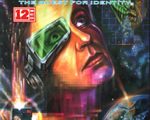

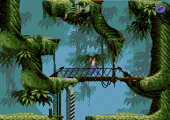
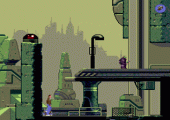
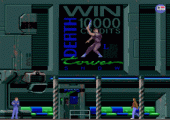
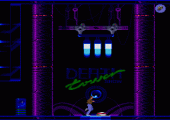
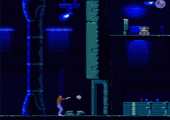
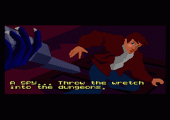
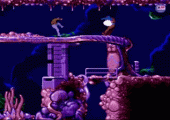
This was one of my favorite games back in the day for Genesis. The animation still holds up well today.